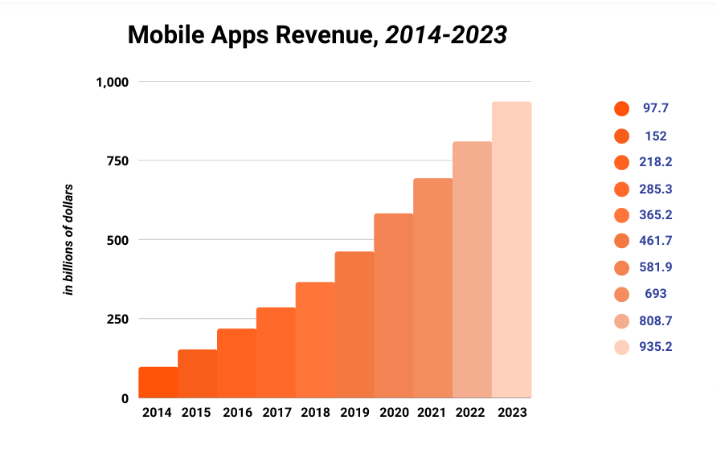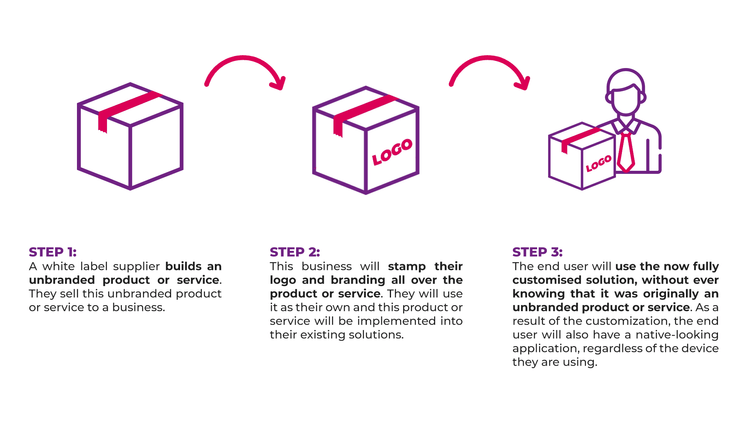
Top 9 SaaS Trends: Every Company Should Follow in 2025
The SaaS market has been exploding since it was introduced two decades ago. SaaS products are irreplaceable for numerous companies as they are reliable and cost-friendly. They provide the true value of the money users spend; therefore, their adoption rate is skyrocketing.
Traditional on-premises software is no longer a trend. SaaS is becoming increasingly prominent. According to a report by BetterCloud, SaaS applications hold a 70% stake in total company software use. The average number of applications used by companies was 8 in 2015, which reached a whopping 80 in 2021. This is 10x growth in just 7 years.
What Makes Saas So Special?
We acknowledged the fast-paced adoption of SaaS. But the question is why it is becoming so popular and what makes it special. Let’s discuss it.
SaaS’s first and most essential advantage is that it doesn’t require custom installation or hardware. Applications are delivered over the Internet. Additionally, there is no space for maintenance costs as the system updates automatically. It cuts various organization expenses; therefore, it is worth investing in.
Traditional software was deployed manually, took a long time to install, and sometimes contained glitches. SaaS solved those aspects, as the applications are ready to use and have already been configured.
The scalability of SaaS is unmatchable. It allows integrations so that users can run multiple activities from a single system without paying additional costs. In addition, the applications are hosted on the cloud and backed up by the vendor, so there is less risk of security breaches.
The most important thing that makes SaaS unique from the traditional concept is the customization options it offers. All users work on a common infrastructure, yet they can tailor applications according to their business process needs. This lets the SaaS providers upgrade the system frequently, with less customer churn risk and lower adoption costs.
The multitenancy model is growing among SaaS businesses, allowing multiple users to use a particular application as tenants. Customers may be given some customization options, and the database of each customer is divided among them. This type of structure serves enterprises with a smaller budget.
SaaS applications also allow users to execute an audit of business transactions, analyzing past data to identify areas for improvement. This helps them form and develop strategies.
SaaS Trends To Follow In 2025
Artificial Intelligence Integration
Artificial intelligence is becoming increasingly widespread in SaaS tools. A study by PWC stated that AI will contribute around $15.7 trillion to the global economy by 2030.
AI uniquely influences the SaaS market, improving product efficiency in different ways. It allows for better data analysis and finding patterns, which helps in decision-making. SaaS businesses can automate their business processes and their offered services/products. Also, it assists in providing users with personalized experiences. AI enhances work speed and solves data security concerns. It detects malfunctions, data leaks, fraud, and other breaches and prevents cyberattacks.
When SaaS is combined with AI and machine learning, it derives the best results and reduces costs. It enables automating various repetitive tasks such as training, customer contact, marketing campaigns, and upselling. In addition, it will create an entirely new level of customer care. For example, Netflix and Spotify use AI and machine learning algorithms to recommend content according to users’ likes and provide personalization. EE-commerce sites also leverage AI to offer product suggestions according to users’ previous activities.
Emergence Of Vertical SaaS
SaaS applications for every sector and niche are horizontal SaaS, which offers common functionalities. On the other hand, vertical SaaS is an industry—and niche-focused application that includes advanced features for specific needs.
Vertical SaaS has more customer intelligence built-in than any other horizontal application. In addition, predefined metrics and KPIs provide a high level of business values and data governance. It fulfills a particular industry’s unique needs and enables flexibility; therefore, the demand for vertical SaaS is skyrocketing. Additionally, industry-tailored solutions are proven comfortable and cost-effective for business processes.
Vertical SaaS enables a great workflow and increases efficiency. In addition, it targets a limited and specific audience; therefore, the company’s marketing expenses can be reduced as the conversion rate increases. Fintech, healthcare, and retail management sectors are the best fit for vertical SaaS. BioIQ, GuideWire, Innovacer, Veeva, and Silo are some of the ideal examples of vertical SaaS.
Low-Code Is The New Normal
Low-code is the next prominent trend emerging rapidly in the SaaS industry. To make SaaS development easy for everyone, some companies provide low-code or no-code applications thdon’tn’t require specific programming knowledge or tech-savvy skills.
Low-code platforms won’t eliminate the need for development for a company, but they will save developers time and allow them to spend more time innovating products. Development toolkits, drag-and-drop interfaces, and reusable components are included in this platform so that users can develop their applications or websites. In addition, low-code apps will let startups make high-speed MVPs to test more solutions rapidly. Research and Markets predicted that the global low-code market may reach a $187 billion valuation by 2030. It is because of the rapid adoption of low-code and no-code platforms. They save valuable time and ease effort, ultimately improving the company’s profitability. Beamer, SAP, Flutterflow, Mendix, Kissflow, etc., are prominent names in the low-code industry.
Increased Dominance Of Martech
Marketing technology is a pool of various apps that helps organizations improve their promotional campaigns and increase the efficiency of insights. In past years, its growth has slowed as some vendors provided complex features, outdated systems, inflexibility, etc. However, it has regained its growth in recent years as SaaS providers have redefined the martech industry.
As the SaaS industry expands, numerous businesses have concentrated on improving the user experience. They tend to provide different industry-specific solutions and better accessibility. Therefore, the martech industry is proliferating in valuations. According to ContentGrip, martech is now worth $121.5 billion and continues to grow.
Data analytics, business intelligence platforms, and graphic design solutions are new chapters of the martech sector. Aspire, Mangools, Ahrefs, and Canva are prominent leaders in the martech industry.
Also read: SaaS Metrics – Defining The SaCompany’sy’s Success
Mobile Apps Are Prioritized

Image(Source)
As the image shows the growth of the mobile app market, more and more SaaS providers are implementing a mobile-first approach. The mobile app market is a growing space for successful business development; therefore, organizations are turning towards it.
SaaS vendors are releasing their mobile apps and constantly trying to include every functionality of the web version. Communication and task management platforms are widespread among businesses handling various processes.
The mobile app industry is skyrocketing due to constant jumps in average users. According to CNBC, around two billion people access the Internet through their smartphones, and the number will reach approximately 3.7 billion by 2025. Youtube, Facebook, Evernote, and Airbnb are popular platforms that adopted a mobile-first approach for their users.
Improved Data Security
Data is the most accurate thing in modern times, and securing it should be more precise. Therefore, it becomes mandatory for SaaS vendors to store the data in a secure place to avoid breaches.
SaaS providers adopt encryption, passwords, data backup, and numerous other methods to secure users’ data. Users are also becoming aware of data breaches and demanding transparent and clear data policies to ensure that their valuable information is in safe hands. GDPR is the best example to understand this.
Various SaaS models are well-known for their enterprise-level security, as AI and machine learning improve threat identification and mitigation.
FortKnox, Helios, SmartFiles, and SiteContinuity are SaaS platforms with the best data security.
SaaS White Labeling

Image(Source)
White labeling is a process in which the application is created by one person, and the buyer of that particular platform sells it under his label. This trend encourages businesses that can set a good market for their product but do not have technical skills and development resources. It can also be helpful for startups, as it doesn’t require a lot of investment.
The business can focus on other valuable aspects, such as branding, strategies, and
value proposition, if a platform framework is available. Email marketing, BI dashboards, development tools, and integration software are usually white-labeled.
Additionally, due to higher demands, e-commerce sites, taxi services, food delivery, healthcare, grocery stores, and home services are white-labeled. AppInstitute, Mautic, GreenRope, 3dcart, Textbroker, and Zopto are prominent platforms allowing businesses to create and white-label different SaaS applications.
Companies Migrating To PaaS
Numerous companies have their own data centers to meet IT needs. However, this results in high expenditures and lower profits. So, they migrate their services to PaaS (platform as a service). Soon after relocating to the PaaS, the business gets an advanced infrastructure and different operational services such as databases, backups, recovery, storage, monitoring, VPN, and security.
PaaS helps SaaS providers launch add-ons for their products effectively and also ensures cost-effectiveness. Therefore, it is a highly scalable and flexible solution that provides a more personalized experience.
UK-based food delivery app Deliveroo uses AWS EC2 tools to scale the geographical market. The startup’s expansion plan succeeded, and the search interest rate increased by 26% in five years. Despite AWS, other PaaS platforms provide startups with an advanced infrastructure where they can manage different activities and build add-ons. Google App Engine, Azure, Force.com, and Acquia are some ideal examples of these platforms.
More Importance To SaaS Analytics
Data is becoming increasingly important, as many companies are entirely data-driven. SaaS providers emphasize data to streamline their processes and gain deep insights into customers. That’s why analytics is the next big player in SaaS trends.
According to BusinessWire, the SaaS-based business analytics market will grow by approximately $7.42 billion between 2020 and 2025, increasing at a CAGR of 13%. Analytics tools are the most rapidly growing SaaS applications, allowing businesses to analyze users’ behaviors. It helps reduce churn rates, increase customer engagement, and grow recurring revenue.
SaaS analytic tools provide ease of strategy to the business as they alert whether a user is dropping off due to a marketing message, product feature, bug, or support issue. It also enables suggestions for how to address that. So, the product manager or executives can identify patterns and build strategies accordingly.
SaaS analytics tools enable constant monitoring of growth KPIs and help managers fine-tune results. They even help organizations track subscription updates and prepare reports to note total changes. This way, the company management can know where the business is and where it will go, so strategies can be formed accordingly. Analytics shows the business’s position in the market in real time and assists the company in keeping pace with competitors; therefore, analytics is one of the most trusted SaaS trends for SaaS businesses.
Concluding Thoughts
SaaS is not just limited to IT companies; it is becoming the leader in all business sectors. All industries and companies are implementing SaaS solutions, regardless of their size. SaaS is increasing because of its time-saving functionalities and practical features. In addition, everything is going digital, and the productivity of businesses is skyrocketing. With these drastic changes, the number of SaaS companies is also increasing. According to Statista, there were around 25,000 SaaS companies across the globe in 2021, and the number is rising rapidly. Thus, SaaS providers have to keep pace with the latest SaaS trends to stay competitive.




